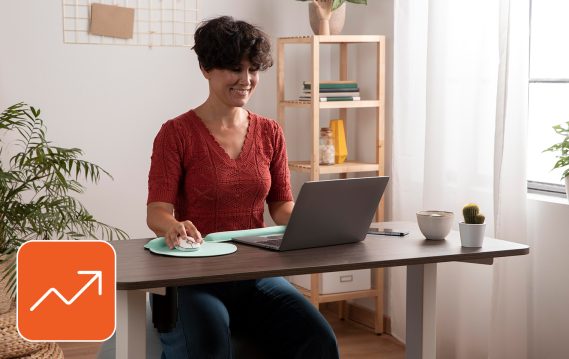If you frequently work from home, good for you: you’re the master of your schedule, working from your own setting and benefiting from increased flexibility. But for some, the home office can often become chaotic and disorganized. One day, you’re typing furiously from the couch. The next, you’re hunched over the kitchen counter. By Friday, your back and neck don’t feel great, to say the least.
Here’s what no one tells you: Those “temporary” aches? They kill your productivity over time. Slouching over your laptop isn’t just stiffening your shoulders. It’s draining your focus, one awkward angle at a time. Meanwhile, you’re blaming the long hours for foggy, error-prone output.
A cluttered workspace doesn’t just look messy; it scrambles your thinking, making it harder to prioritize tasks or hit creative flow.
And that nagging discomfort? It trains your brain to associate work with pain, fueling procrastination and burnout.
Over weeks or months, these small compromises snowball: you lose hours to fatigue, your work quality dips, and suddenly, the freedom of remote working or freelancing feels like a trap.
In this blog, we are going to show you how to turn that chaotic corner of your home into an ergonomic workspace that’s kind to your body and mind (and also your pocket).
Figuring out what an ergonomic workstation means for you:
Ergonomics is defined as “relating to or designed for efficiency and comfort in the working environment.” While we will lay out the foundation for an ergonomic home office in this guide, you should definitely consider what workstation features make you most comfortable and efficient.
A few of the things you might consider include the fact that your workspace might need to adapt to irregular hours, multiple projects, and even shared living areas. Let’s break down how to design a setup that supports both your body and your workflow.
5 Steps to Creating An Ergonomic Workstation
Make flexibility a rule
Chances are you switch between different types of tasks, emails, video calls, and other tasks. You write, code, design, reconcile, or tally. The point is that your ergonomic workspace should keep up. Opt for lightweight, portable furniture like foldable desks or chairs that can be tucked away if your “office” doubles as a living room or kitchen table.
If you’re working in tight spaces, consider a rolling cart to store supplies or a laptop stand that adjusts height for sitting or standing.
Flexibility also means ensuring your tech setup works across devices. Position monitors, tablets, or laptops at eye level, and use affordable adapters to connect older equipment.
Repurpose what you already have
You don’t need to break the bank for one of those fancy ergonomic office chairs. Start by repurposing what you have. A kitchen chair can become an ergonomic office chair with cushions for support and a rolled-up towel under your wrists to keep them neutral while typing.
You can also look at used ergonomic chairs if you’re on a tight budget.
You may also want to invest in small upgrades like a vertical mouse (to reduce wrist strain) or a secondhand monitor to avoid hunching over a tiny screen.
Invest strategically. Don’t buy everything you read about.
A graphic designer might prioritize a tilting desk for a drawing tablet, while a writer could benefit from blue-light glasses and a split keyboard.
On the other hand, if you’re on video calls daily, making presentations with your camera on, you might invest in a budget ring light and declutter your background.
When investing in creating an ergonomic home office, choose items that will really make a difference to your comfort and efficiency. To avoid impulse buying, create a wishlist and make purchases only after careful consideration over a week or so.
Switch to better lighting
Natural light is free and boosts focus, so position your desk near a window, but angle it sideways to avoid glare on your screen.
You can also improve the environment of your ergonomic workstation by adding a cheap LED desk lamp with adjustable brightness for late-night gigs or client calls. In fact, we recently implemented this in our Minnesota office and can vouch for the impact! We got some pretty table lamps to use as an alternative to the bright ceiling lamps that can sometimes get overwhelming, and our team members are thrilled with the vibe.
If noise is an issue, hang thick curtains or lay down a rug to dampen sound, and use noise-canceling headphones.
In addition, a small plant or two can improve air quality and make the space feel less sterile, which is key for creativity during long workdays.
Don’t forget intangibles
The world’s most ergonomic workstation isn’t going to help you be more productive if you forget about the mental aspects of efficiency and comfort, namely rest and work-life balance.
Remote workers often blur the lines between work and personal time, so be sure to set physical and mental boundaries.
Tips:
- Use a room divider or even a curtain to separate your workspace from your living area.
- Stick to routines: try the Pomodoro Technique (25 minutes of work, 5-minute breaks) to avoid burnout
- Use free apps like Toggl to track billable hours.
- At the end of the day, shut down your devices and “commute” out of your office (even if it’s just a walk around the block) to signal to your mind and body that work is done. And yes you need to do this even after you’ve transformed the space into an ergonomic home office.
Pro tip: Check about tax deductions
Some of those ergonomic workstation upgrades might be tax-deductible!
Save receipts for chairs, desks, software, or even a portion of your internet bill. If you occasionally rent a co-working space for focused work, those costs might qualify too. A quick chat with an accountant could save you hundreds when you file your taxes.
Tl;dr
Avoid the couch at all costs. It’s a posture killer. Instead, create a dedicated ergonomic workstation, even if it’s just in the corner of a room. Declutter regularly (a messy desk distracts the mind), and reassess your setup every few months. Small tweaks, like raising your monitor or adding a footrest, can prevent chronic pain. Remember, your health and productivity are worth the effort. Moreover, with a little creativity, you don’t need a corporate budget to build a workspace that works for you. Get more ideas on improving your home office in this blog and this video by the Wall Street Journal.
What About Scaling Your Client List?
Now that your workspace is primed for productivity, why stop there? Imagine pairing your new ergonomic home office with a new role that matches your skills and your ambition.
That’s where SPECTRAFORCE comes in. We’ve got an experienced team of recruiters, backed by our proprietary AI tool, Arya, that goes beyond the resume to understand your many skills and interests, and find you roles that give you NEWJOBPHORIA. Whether you’re hunting for short-term contracts, dream projects, or a foot in the door at Fortune 500 brands, we can help you make it happen.
Ready to experience NEWJOBPHORIA? Visit our website today, explore our job board, and submit your resume to find your next dream job.



